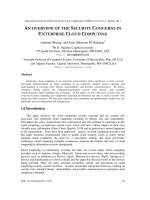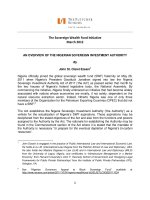Direct and indirect speech an overview of the rules
Bạn đang xem bản rút gọn của tài liệu. Xem và tải ngay bản đầy đủ của tài liệu tại đây (8.86 KB, 2 trang )
Direct and indirect speech: an overview of the rules
When the reporting verb is in the past tense, all present tenses in the direct speech will change into the
corresponding past tenses.
For example, the simple present will become simple past.
He said, ‘I want to go.’
He said that he wanted to go.
The present continuous will become the past continuous.
She said, ‘I am coming.’
She said that she was coming.
The present perfect will become the past perfect.
He said, ‘I have finished.’
He said that he had finished.
If the reporting verb is in the present tense, the tenses in the direct speech do not change.
He says, ‘He is leaving.’
He says that he is leaving.
When we report questions, the indirect speech is introduced by verbs such as asked, inquired etc.
He said to me, ‘What are you doing there?’
He asked me what I was doing there.
To report an Yes/No question, we use if or whether.
He said to me, ‘Are you interested?’
He asked me if I was interested.
He said to them, ‘Will you listen to such a man?’
He asked them whether they would listen to such a man.
When we report commands and requests, the indirect speech is introduced by verbs expressing a command or
request. Examples are: ordered, requested, commanded, shouted etc.
The master said to the servant, ‘Go away.’
The master ordered the servant to go away.
He said to them, ‘Please wait here till I return.’
He requested them to wait there till he returned.
Stay on top of your writing! Download our grammar guide from www.englishgrammar.org to stay up-to-date.
Powered by TCPDF (www.tcpdf.org)









